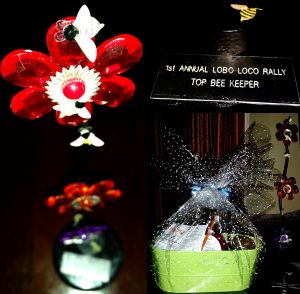Out for a ride the other day, I had a hybrid car driver go off unprovoked about how un-environmental motorcycles are. My son and I were two-up on my 2010 Kawasaki Concours 14 when we pulled in to a stop and got unsolicited advice from the ignorant.
There are lighter bikes with smaller motors that get significantly higher gas mileage, but the Connie does a fine job of moving two people through the world using amazingly little in terms of natural resources. It also has a virtuous manufacturing history compared to many other vehicles, especially ones that move on lithium power.
This proud-Prius driver got his back up when I suggested that my bike gets better mileage than his dual-engined hybrid (it does – his AWD Prius gets 52/48mpg on its city/highway cycles, my C14 is currently averaging 4.5 litres/100kms mostly two up, which works out to just over 52mpg). That Toyota, like my Kawasaki, is made in Japan by unionized workers who are paid a living wage to build world-class machines. Being Japanese, they also both lean heavily on locally manufactured parts. More and more vehicles are being built in developing countries, which can be a good thing but can also be an excuse to force labour on people who could never afford what they’re building. Globalism doesn’t like to show the off-shore slavery that makes it run.
Where I think our two vehicles diverge are in the inherent compromises in the design of that Toyota. Lugging around two seperate drivetrains is incredibly inefficient. It’s impressive that the hybrid drive has evolved to the point where it can post the mileage numbers it does, but it’s still having to lug around a gas tank and gasoline powered motor in addition to batteries and electric motors. Other than the much-vaunted fuel efficiency, the cost of maintenance must be miserable. By comparison, the efficient shaft-drive and motor on the Kwak are designed to do hundreds of thousands of high-efficiency (or fast if you prefer) miles without any of that overhead.
The most onerous (and hidden) part of that mechanical overhead are the lithium batteries in that hybrid. I teach computer engineering as my day job and I’m well up on our medieval battery power development. We are stuck with poor performing, environmentally bankrupt, chemical battery technology from somewhere in the late 19th Century. Instead of addressing the immanent climate emergency by producing smaller, more efficient vehicles, we’re using electric and hybrid electric as an excuse to produce slightly more efficient behemoths.
Lithium batteries are a nightmare. From a safety standpoint they are a potentially explosive disaster and from a power to weight ratio they are next to useless, but they’re the best we have. The nightmare gets worse though when you look at how we’re managing lithium production in a world that desperately needs more of it. As you’d expect, transnational companies with no real oversight are abusing developing countries (as they have since colonial times) with aggressive economic tactics in order to strip local peoples of the natural resources beneath their feet. International mining concerns ferment government instability in order to ensure cheap access to in-demand resources. Money likes to condense where it already exists and the electric car battery market has all the hallmarks of blood diamonds in terms of the distribution of wealth involved.
There are a lot of advantages to electric vehicles and I hope to get into them sooner than later, but these early adopter vehicles are being driven by and for the privileged wealthy and are mined and manufactured by environmentally and socially bankrupt transnational companies chasing dollar signs (as it has always been).
If you’re all about leveraging your privilege in order to wander around with your chest out bragging about how much you care about the planet, do a bit of research first. There is a darkside to rushing electric vehicle sales before we’ve worked out the tech that amplifies rather than resolves our resource shortages. The immanent climate disaster needs solutions, not a shell-game where old white guys get to tell everyone about how much they care by driving overweight, compromised designs based more on marketing than actually solving the coming crisis.
That same day we filled up before riding home. I put $28 of premium in to fill up the bike. The guy next to me pulled up in a new hybrid F150 pickup truck that looked bigger than a house. He proceeded to put nearly $200 of gas into it. I asked him how far that’d get him and he told me about how the hybrid electric was so efficient that he’d get about a thousand kilometers to the tank. I get just shy of 500 to a tank on the bike, so for what he put in I could cover 2000kms. I know this is apples to oranges as that pickup could do things the bike can’t, like carry loads, except this one with its never used bed and chrome wheels wasn’t carrying much of anything, and therein lies the real issue with this hybrid fad; instead of directing us to use less (which would actually help us deal with the climate emergency), hybrid technology is being used by car companies to justify an unsustainable habit of ever larger and improbable vehicles. If we could all do more with less we might just make it out of this mess.
The Corvette owners club rocked up at the gas station then. The new Vette goes 0-60 almost a fast as my decade old Connie while using twice the fuel. With only two seats it makes a more direct comparison with the bike in terms of functionality and usefulness. The plethora of old white guys who hopped out of their new Vettes all spent 12 to 15 times what I did to buy their toys, the difference is that my gasoline powered recreational decisions aren’t burning a hole in the world.
If you really want to help out, get smaller and use less – riding a bike is a great place to start. Your other option is to keep playing into the enviro-marketing games until we’re all watching the world burn to the ground around us. I won’t go into how charging all these electric vehicles on our already overloaded and vulnerable electrical infrastructure is going to poke holes in other aspects of life. We need people to change their minds about what green is, and the first step isn’t to throw technology at old habits, it’s to do more with less.
Some Research on Battery Powered Vehicles (in case you can’t be bothered to do it yourself)
https://www.varsity.co.uk/science/20401
Starving arid regions of their drinking water to feed the world’s insatiable appetite for lithium? If you know where the technology comes from, it gets difficult to stay on that high horse.
“The ethics of electric vehicles is far more complicated than the expensive car adverts and glowing newspaper headlines would have us believe.”
https://www.thoughtco.com/lithium-production-2340123
Lithium production is a messy business.
https://www.aps.org/publications/apsnews/201208/backpage.cfm
Lithium development has stalled and initial optimism is fading. You’re not going to be preplacing your worn out lithium batteries with something better in your EV any time soon – but you will be replacing them with yet more lithium.
https://www.ford.ca/trucks/f150/f150-lightning/2022//?gnav=header-trucks-vhp
Instead of immanent climate disaster modifying our driving habits and producing smaller vehicles that use less of everything, we’re leveraging electric vehicles to keep churning out excess. When people plug in behemoths like this we’ll end up having to turn on coal powered hydro plants just to keep the lights on.
With Ontario spending hundreds of millions to cancel carbon neutral electricity production, we all appear more than happy to simply hide our carbon output rather than actually reduce it.
https://www.energyvoice.com/renewables-energy-transition/158058/bmw-i3-ad-pulled-due-misleading-electric-vehicle-claims/
Car companies are selling environmentalism hard, even when what they’re selling isn’t.










